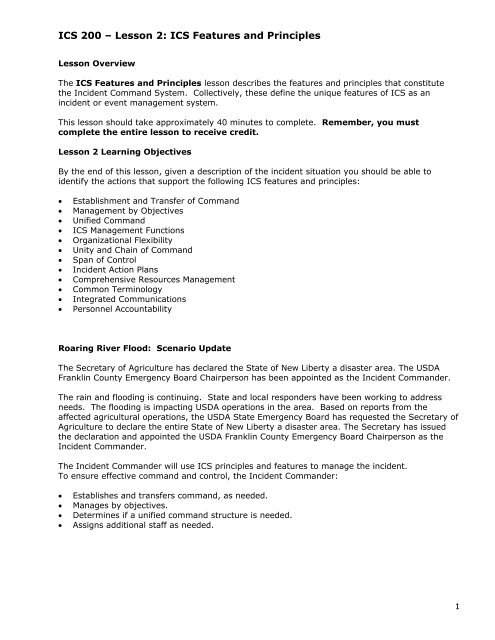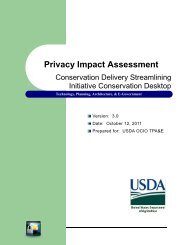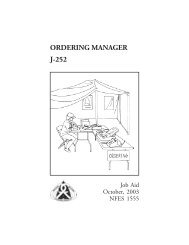ICS 200 â Lesson 2: ICS Features and Principles - US Department ...
ICS 200 â Lesson 2: ICS Features and Principles - US Department ...
ICS 200 â Lesson 2: ICS Features and Principles - US Department ...
You also want an ePaper? Increase the reach of your titles
YUMPU automatically turns print PDFs into web optimized ePapers that Google loves.
<strong>ICS</strong> <strong>200</strong> – <strong>Lesson</strong> 2: <strong>ICS</strong> <strong>Features</strong> <strong>and</strong> <strong>Principles</strong><strong>Lesson</strong> OverviewThe <strong>ICS</strong> <strong>Features</strong> <strong>and</strong> <strong>Principles</strong> lesson describes the features <strong>and</strong> principles that constitutethe Incident Comm<strong>and</strong> System. Collectively, these define the unique features of <strong>ICS</strong> as anincident or event management system.This lesson should take approximately 40 minutes to complete. Remember, you mustcomplete the entire lesson to receive credit.<strong>Lesson</strong> 2 Learning ObjectivesBy the end of this lesson, given a description of the incident situation you should be able toidentify the actions that support the following <strong>ICS</strong> features <strong>and</strong> principles:• Establishment <strong>and</strong> Transfer of Comm<strong>and</strong>• Management by Objectives• Unified Comm<strong>and</strong>• <strong>ICS</strong> Management Functions• Organizational Flexibility• Unity <strong>and</strong> Chain of Comm<strong>and</strong>• Span of Control• Incident Action Plans• Comprehensive Resources Management• Common Terminology• Integrated Communications• Personnel AccountabilityRoaring River Flood: Scenario UpdateThe Secretary of Agriculture has declared the State of New Liberty a disaster area. The <strong>US</strong>DAFranklin County Emergency Board Chairperson has been appointed as the Incident Comm<strong>and</strong>er.The rain <strong>and</strong> flooding is continuing. State <strong>and</strong> local responders have been working to addressneeds. The flooding is impacting <strong>US</strong>DA operations in the area. Based on reports from theaffected agricultural operations, the <strong>US</strong>DA State Emergency Board has requested the Secretary ofAgriculture to declare the entire State of New Liberty a disaster area. The Secretary has issuedthe declaration <strong>and</strong> appointed the <strong>US</strong>DA Franklin County Emergency Board Chairperson as theIncident Comm<strong>and</strong>er.The Incident Comm<strong>and</strong>er will use <strong>ICS</strong> principles <strong>and</strong> features to manage the incident.To ensure effective comm<strong>and</strong> <strong>and</strong> control, the Incident Comm<strong>and</strong>er:• Establishes <strong>and</strong> transfers comm<strong>and</strong>, as needed.• Manages by objectives.• Determines if a unified comm<strong>and</strong> structure is needed.• Assigns additional staff as needed.1
<strong>ICS</strong> <strong>200</strong> – <strong>Lesson</strong> 2: <strong>ICS</strong> <strong>Features</strong> <strong>and</strong> <strong>Principles</strong>Roaring River Flood: Scenario Update (continued)The st<strong>and</strong>ard <strong>ICS</strong> organizational structure helps the Incident Comm<strong>and</strong>er to:• Establish management functions.• Ensure unity of comm<strong>and</strong>• Maintain a clear chain of comm<strong>and</strong>.• Create a flexible organizational structure.• Manage the span of control.Planning is a critical <strong>ICS</strong> component for ensuring that there will be a comprehensive managementstrategy for the incident. Effective Incident Comm<strong>and</strong>ers manage by objectives. The objectivesare set forth in the Incident Action Plans, <strong>and</strong> drive all decisions about operations <strong>and</strong> resourceallocation. To facilitate the flow of information, the Incident Comm<strong>and</strong>er:• Requires all incident personnel to use common terminology.• Establishes integrated communication systems.Clear chain of comm<strong>and</strong>, delegation of authority, <strong>and</strong> resource tracking ensures personnelaccountability for assignments.Establishment of Comm<strong>and</strong>The first arriving authority at the scene, who has jurisdiction for the incident, establishes incidentcomm<strong>and</strong> <strong>and</strong> identifies the initial Incident Comm<strong>and</strong> Post (ICP). The initial IncidentComm<strong>and</strong>er will also:• Establish needed authorization <strong>and</strong> delegations of authority. These agreements allowthe Incident Comm<strong>and</strong>er to act on behalf of the Secretary, State Emergency Board <strong>and</strong> otherswho have responsibilities for the incident. They also allow the Incident Comm<strong>and</strong>er to makedecisions <strong>and</strong> allocate funds.• Begin establishing incident facilities. The next priority is to establish the incidentfacilities, beginning with the Incident Comm<strong>and</strong> Post.• Consider the need to transfer comm<strong>and</strong>.Responsibility for Incident Comm<strong>and</strong>Frequently, comm<strong>and</strong> does not stay with the initial Incident Comm<strong>and</strong>er. A primary principle of<strong>ICS</strong> is the ability to assign the most experienced <strong>and</strong> skilled person as the Incident Comm<strong>and</strong>er,regardless of that employee’s agency.When the Agency Administrator(s) assigns the Incident Comm<strong>and</strong>er, the Administrator(s)delegates the appropriate agency authorities to that Incident Comm<strong>and</strong>er.The process of moving the responsibility for incident comm<strong>and</strong> from one person to another iscalled transfer of comm<strong>and</strong>. All transfers of comm<strong>and</strong> must be approved by the agency.2
<strong>ICS</strong> <strong>200</strong> – <strong>Lesson</strong> 2: <strong>ICS</strong> <strong>Features</strong> <strong>and</strong> <strong>Principles</strong>Transfer of Comm<strong>and</strong>The initial Incident Comm<strong>and</strong>er will remain in charge until transfer of comm<strong>and</strong> is accomplished.Comm<strong>and</strong> may transfer to higher qualified or more experienced personnel from the same agency,or be transferred to the employee of another responsible agency.Higher qualified persons arriving at an incident may:• Assume comm<strong>and</strong> (according to agency guidelines).• Maintain comm<strong>and</strong> as it is.• Transfer comm<strong>and</strong> to a better qualified or more experienced Incident Comm<strong>and</strong>er.Transfer of comm<strong>and</strong> begins with an initial briefing on the extent of damage <strong>and</strong> probableresponse needs.Other Reasons To Transfer Comm<strong>and</strong>Comm<strong>and</strong> may be transferred when:• A more qualified person is available to assume comm<strong>and</strong>.• A jurisdiction or agency is legally required to take comm<strong>and</strong>.• Changing comm<strong>and</strong> makes good sense.• The incident complexity changes.• There is turnover of personnel on long or extended incidents.• Personnel are called home for any reason.• Agency Administrators direct a change in comm<strong>and</strong>.Roaring River Flood: Establishment <strong>and</strong> Transfer of Comm<strong>and</strong>Let’s return to the Roaring River Incident.Initially, the <strong>US</strong>DA Franklin County Emergency Board Chairperson was appointed as the IncidentComm<strong>and</strong>er. As the incident exp<strong>and</strong>ed, comm<strong>and</strong> was transferred to an experienced member ofthe <strong>US</strong>DA’s Animal <strong>and</strong> Plant Health Inspection Service (APHIS) Federal Incident ManagementTeam.3
<strong>ICS</strong> <strong>200</strong> – <strong>Lesson</strong> 2: <strong>ICS</strong> <strong>Features</strong> <strong>and</strong> <strong>Principles</strong>Management by ObjectivesWithin <strong>ICS</strong>, management by objectives covers six essential steps. These steps take place onevery incident regardless of size or complexity.Roaring River Flood: Initial Incident ObjectivesThere’s so much that needs to be accomplished <strong>and</strong> it is easy to lose track of what has priority.The Incident Comm<strong>and</strong>er must establish incident objectives from the onset. Identifyingobjectives allows Comm<strong>and</strong> <strong>and</strong> General Staff members to determine strategy, tactics, <strong>and</strong>resource needs.Incident Comm<strong>and</strong>er“There’s so much that needs to be accomplished, we need to focus quickly. Based on our mosturgent priorities, we have established two initial objectives for the incident.The first objective is to verify the initial assessments.The second objective is to develop plans <strong>and</strong> acquire the needed resources to accomplish thefollowing:• Ensure the safety <strong>and</strong> welfare of the personnel who will be assigned to this incident.• Protect the food supply. One of our greatest concerns is to make sure no contaminated foodmakes it onto grocery shelves.• Euthanize those animals that are suffering.• Collect <strong>and</strong> dispose of animal carcasses.• Destroy the escaped fruit flies <strong>and</strong> prevent further reproduction.Identifying these initial objectives will allow our Comm<strong>and</strong> <strong>and</strong> General Staff members todetermine our strategy, tactics, <strong>and</strong> resource needs.”4
<strong>ICS</strong> <strong>200</strong> – <strong>Lesson</strong> 2: <strong>ICS</strong> <strong>Features</strong> <strong>and</strong> <strong>Principles</strong>Unified Comm<strong>and</strong>In <strong>ICS</strong>, Unified Comm<strong>and</strong> is a unified team effort which allows all agencies with responsibility forthe incident, either geographical or functional, to assign an Incident Comm<strong>and</strong>er to the UnifiedComm<strong>and</strong>. The Incident Comm<strong>and</strong>ers in the Unified Comm<strong>and</strong> establish a common set ofincident objectives <strong>and</strong> strategies.This type of comm<strong>and</strong> structure is accomplished without losing or giving up agency authority,responsibility, or accountability.Roaring River Flood: Unified Comm<strong>and</strong>Because of the involvement of local, State, <strong>and</strong> Federal agencies, the Roaring River IncidentComm<strong>and</strong>er considers using a unified comm<strong>and</strong>. After careful consideration, the IncidentComm<strong>and</strong>er decides not to establish a unified comm<strong>and</strong> for the following reasons:• The <strong>Department</strong> of Agriculture’s responsibilities are clearly separate from <strong>and</strong> easily conductedindependently of ongoing State <strong>and</strong> local flood response activities.• There are few resources currently assigned to the incident, <strong>and</strong> other agencies such as FEMAhave not yet been deployed.Unified comm<strong>and</strong> could be used later in the incident response, if warranted.<strong>ICS</strong> Management FunctionsFive major management functions are the foundation upon which the <strong>ICS</strong> organization develops.The five major <strong>ICS</strong> functions are as follows:Comm<strong>and</strong>: Sets incident objectives <strong>and</strong> priorities <strong>and</strong> has overall responsibility at the incident orevent.Operations: Conducts tactical operations to carry out the plan. Develops the tacticalassignments <strong>and</strong> organization, <strong>and</strong> directs all tactical resources.Planning: Prepares <strong>and</strong> documents the Incident Action Plan to accomplish the incidentobjectives, collects <strong>and</strong> evaluates information, maintains resource status, <strong>and</strong> maintainsdocumentation for incident records.Logistics: Provides support, resources, <strong>and</strong> all other services needed to meet the incidentobjectives.Finance/Administration: Monitors costs related to the incident. Provides accounting,procurement, time recording, <strong>and</strong> cost analyses.5
<strong>ICS</strong> <strong>200</strong> – <strong>Lesson</strong> 2: <strong>ICS</strong> <strong>Features</strong> <strong>and</strong> <strong>Principles</strong>Roaring River Flood: Management Functions ActivitySituation: At this point in the incident, the Incident Comm<strong>and</strong>er has a limited number of staffmembers who can be assigned to management functions.What is the Incident Comm<strong>and</strong>er’s best course of action?The Incident Comm<strong>and</strong>er’s best course of action is to assume responsibility for all functionsthat cannot be staffed <strong>and</strong> delegated.Every incident or event requires that certain management functions be performed. Even if anincident is very small, <strong>and</strong> only one or two people are involved, these activities will still alwaysapply to some degree. Remember:• Comm<strong>and</strong> should never be delegated. In addition, comm<strong>and</strong> should always be exercised fromthe Incident Comm<strong>and</strong> Post.• Delaying planning is not a good option. Without an effective planning function, incidentmanagement will become increasingly chaotic <strong>and</strong> ineffective, <strong>and</strong> will most likely fail.• Rotating assignments is not viable because it would result in an unclear chain of comm<strong>and</strong><strong>and</strong> a lack of management continuity.Organizational FlexibilityThe <strong>ICS</strong> organization reflects the principle of management by objectives. Every incident hasdifferent requirements. The organizational structure should reflect only what is required to meet<strong>and</strong> support planned incident objectives.The size <strong>and</strong> structure of the current organization is determined by the incident objectives. Eachactivated element must have a person in charge of it. As objectives are achieved, elements thatare no longer needed should be reassigned, or demobilized.Roaring River Flood: Implementing Organizational FlexibilityThis incident is going to need a lot of planning <strong>and</strong> logistical support. To support our initialincident objectives we need to assign staff to verify the initial assessments.Incident Comm<strong>and</strong>er“This incident is going to need a lot of planning <strong>and</strong> logistical support. To support our initialincident objectives, we need to assign staff to verify the initial assessments.Considering the large flood impact area, there’s likely to be a lot of competition for resources.And after we secure needed resources, it will take some time for them to mobilize. And ofcourse, the organization will exp<strong>and</strong> to reflect the tactics related to implementing the objectives.What’s important is that we exp<strong>and</strong> the structure based on operational needs <strong>and</strong> without chaos.I plan to activate the Section Chiefs first. Each Chief in turn will manage the assigned function<strong>and</strong> determine appropriate staffing.”6
<strong>ICS</strong> <strong>200</strong> – <strong>Lesson</strong> 2: <strong>ICS</strong> <strong>Features</strong> <strong>and</strong> <strong>Principles</strong>Unity <strong>and</strong> Chain of Comm<strong>and</strong>In the Incident Comm<strong>and</strong> System:• Unity of comm<strong>and</strong> means that every individual has only one designated supervisor.• Chain of comm<strong>and</strong> means that there is an orderly line of authority within the ranks of theorganization, with lower levels subordinate to, <strong>and</strong> connected to, higher levels.The above <strong>ICS</strong> principles are used to communicate direction <strong>and</strong> maintain management control.These principles do not apply to the exchange of information. Although orders must flow throughthe chain of comm<strong>and</strong>, members of the organization may directly communicate with each other toask for or share information.<strong>ICS</strong> team members work within the <strong>ICS</strong> position descriptions <strong>and</strong> follow the designated chain ofcomm<strong>and</strong>, regardless of their nonemergency positions or everyday administrative chain ofcomm<strong>and</strong>.Unity <strong>and</strong> Chain of Comm<strong>and</strong>In almost 95 percent of all incidents, the organizational structure for incident management willconsist of comm<strong>and</strong> <strong>and</strong> single resources. A single resource is an individual, a piece of equipment<strong>and</strong> its personnel complement, or a crew or team of individuals with an identified work supervisorthat can be used at an incident.However, as incidents exp<strong>and</strong>, the chain of comm<strong>and</strong> is established through an organizationalstructure that can consist of several layers, as needed, such as:• Comm<strong>and</strong>: The Comm<strong>and</strong> Staff consists of the Public Information Officer, Safety Officer, <strong>and</strong>Liaison Officer. They report directly to the Incident Comm<strong>and</strong>er. They may have one or moreassistants, as needed.• Sections: A Section is the organizational level with responsibility for a major functional areaof the incident (e.g., Operations, Planning, Logistics, Finance/Administration). Section Chiefsmanage sections.• Branches: A Branch is the organizational level having functional or geographic responsibilityfor major parts of incident operations. Branch Chiefs are in charge of Branches.• Divisions/Groups: Divisions are used to divide an incident geographically. Groups are usedto describe functional areas of operations. Divisions <strong>and</strong> Groups are managed byDivision/Group Supervisors.• Units: A Unit is the organizational element having functional responsibility for a specificincident planning, logistics, or finance/administration activity. Units are managed by UnitLeaders.• Task Forces/Strike Teams: Task Forces are composed of unlike resources. Strike Teamsare composed of like resources. Both Task Forces <strong>and</strong> Strike Teams must be organized withinspan of control guidelines, <strong>and</strong> have common communications <strong>and</strong> a Leader.• Resources: Resources are personnel <strong>and</strong> equipment available, or potentially available, forassignment to incidents. Resources are described by kind <strong>and</strong> type (e.g., ground, water, air,etc.) <strong>and</strong> may be used in tactical support or overhead capacities at an incident.7
<strong>ICS</strong> <strong>200</strong> – <strong>Lesson</strong> 2: <strong>ICS</strong> <strong>Features</strong> <strong>and</strong> <strong>Principles</strong>Span of ControlSpan of control pertains to the number of individuals one supervisor can effectively manage. It isespecially important to maintain an effective span of control at incidents where safety <strong>and</strong>accountability have top priority.Management studies have shown that the span of control for a supervisor falls within a range ofthree to seven, depending upon the skills of the supervisor <strong>and</strong> the complexity of the task beingoverseen. If a supervisor has fewer than three or more than seven people reporting, someadjustment to the organization should be considered.The general rule for span of control in <strong>ICS</strong> is one supervisor to five subordinates.Incident Action PlanAn Incident Action Plan is developed for each operational period (for example, every 12 hours).The purpose of the Incident Action Plan is to provide all incident supervisory personnel withappropriate direction for that operational period. The plan may be verbal or written.Written Incident Action PlanAll levels of a growing organization must have a clear underst<strong>and</strong>ing of the tactical actions for thenext operational period. It is recommended that written plans be used whenever:• Verbal plans could result in the miscommunication of critical information.• Two or more jurisdictions or disciplines are involved.• Large changes of personnel occur by operational periods.• Personnel are working across more than one operational period.• There is a full activation of the <strong>ICS</strong> organization.• The incident has important legal, political, or public ramifications.• Complex communication issues arise.In addition, the Incident Comm<strong>and</strong>er may direct the organization to develop a written IncidentAction Plan at any time.Documenting the PlanIn <strong>ICS</strong>, an Incident Briefing Form is used on smaller incidents to record initial actions <strong>and</strong> listassigned <strong>and</strong> available resources. As incidents grow in complexity <strong>and</strong>/or size, <strong>ICS</strong> provides aformat <strong>and</strong> process for the development of a written Incident Action Plan.8
<strong>ICS</strong> <strong>200</strong> – <strong>Lesson</strong> 2: <strong>ICS</strong> <strong>Features</strong> <strong>and</strong> <strong>Principles</strong>Comprehensive Resources ManagementAll <strong>ICS</strong> resources are ordered, received, assigned, <strong>and</strong> tracked systematically. Resources includepersonnel, tools, equipment <strong>and</strong> their operators, <strong>and</strong> expendable items (e.g., drugs <strong>and</strong> syringesthat veterinary services will use to euthanize animals, pesticides, etc.).The Incident Comm<strong>and</strong>er uses the Resource Summary on page 4 of <strong>ICS</strong> Form 201 to documentthe resource status. <strong>Lesson</strong> 4 of this course covers resource management in more depth.Initial Incident Objectives: ReviewThe first objective is to verify the initial assessments.The second objective is to develop plans <strong>and</strong> acquire the needed resources to accomplish thefollowing:• Ensure the safety <strong>and</strong> welfare of the personnel who will be assigned to this incident.• Protect the food supply. One of our greatest concerns is to make sure no contaminated foodmakes it onto grocery shelves.• Euthanize those animals that are suffering.• Collect <strong>and</strong> dispose of animal carcasses.• Destroy the escaped fruit flies <strong>and</strong> prevent further reproduction.Roaring River Flood: Incident Objectives ActivitySituation: The <strong>ICS</strong> organization is now fully activated. Tactical assignments are beingestablished for each 12-hour operational period. Staff members have begun working in 12-hourshifts. It is critical that all personnel have a clear underst<strong>and</strong>ing of the tactical actions to beaccomplished in the next operational period.What is the Incident Comm<strong>and</strong>er’s best course of action?The Incident Comm<strong>and</strong>er’s best course of action is to direct the organization to develop awritten Incident Action Plan.As incidents grow in complexity <strong>and</strong>/or size, <strong>ICS</strong> provides a format <strong>and</strong> process for thedevelopment of a written Incident Action Plan. It is recommended that written plans be usedwhenever:• Verbal plans could result in the miscommunication of critical information.• Two or more jurisdictions or disciplines are involved.• Large changes of personnel occur by shifts.• Personnel are working across more than one operational period.• There is a full activation of the <strong>ICS</strong> organization.• The incident has important legal, political, or public ramifications.9
<strong>ICS</strong> <strong>200</strong> – <strong>Lesson</strong> 2: <strong>ICS</strong> <strong>Features</strong> <strong>and</strong> <strong>Principles</strong>Common TerminologyThe ability to communicate within the <strong>ICS</strong> is absolutely critical. An essential method for ensuringthe ability to communicate is by using st<strong>and</strong>ard or common terminology.A critical part of an effective multiagency incident management system is for all communicationsto be in plain English. That is, use clear text. Do not use radio codes, agency-specificcodes, or jargon.Applying Common TerminologyIn <strong>ICS</strong>, common terminology <strong>and</strong> designations are applied to:OrganizationalElementsResourcesFacilitiesPosition TitlesEach <strong>ICS</strong> organizational element (e.g., Sections, Divisions <strong>and</strong>/orGroups, Branches) has a specified title.Some resources have common designations based on their type orkind. Many resources are also classified by type to indicate theircapabilities (e.g., types of helicopters, trucks, heavy equipment, etc.).St<strong>and</strong>ard <strong>ICS</strong> facilities have specific names. Consistent names clarifythe activities that take place at a specific facility, <strong>and</strong> what members ofthe organization can be found there.<strong>ICS</strong> management or supervisory positions are referred to by titles suchas Officer, Chief, Director, Supervisor, etc.Position TitlesThe use of specific position titles in <strong>ICS</strong> serves three important purposes:• Titles provide a common organizational language for multiagency use at an incident. Forexample, confusion can arise if one agency uses the title Branch Chief, another BranchManager, another Branch Officer, etc.• The use of distinct titles for <strong>ICS</strong> positions allows a distinction to be made between theadministrative position <strong>and</strong> rank of the individual <strong>and</strong> the <strong>ICS</strong> position. This allows for filling<strong>ICS</strong> positions with the most qualified individuals rather than by rank.• The lack of st<strong>and</strong>ardization of position titles can also confuse the ordering process whenrequesting qualified personnel. For example, when ordering personnel to fill unit positions,common titles <strong>and</strong> associated qualifications ensure that qualified personnel will be acquired.10
<strong>ICS</strong> <strong>200</strong> – <strong>Lesson</strong> 2: <strong>ICS</strong> <strong>Features</strong> <strong>and</strong> <strong>Principles</strong>Integrated Communications: ElementsEffective <strong>ICS</strong> communications includes three elements:• The “hardware” systems used to transfer information.• Planning for the use of all available communications frequencies <strong>and</strong> resources.• Procedures <strong>and</strong> processes for transferring information internally <strong>and</strong> externally.Integrated Communications: PlanningEvery incident needs a Communications Plan. The plan can be simple <strong>and</strong> stated verbally, or itcan be complex <strong>and</strong> written. A Communications Plan (<strong>ICS</strong> Form 205) is a component of thewritten Incident Action Plan.An awareness of available communications resources, combined with an underst<strong>and</strong>ing of incidentrequirements, will enable the Communications Unit Leader to develop an effectiveCommunications Plan.Integrated Communications: ModesIt is not unusual for the communications needs on large incidents to outstrip available radiofrequency resources.Some incidents are conducted entirely without radio support. In such situations, othercommunications resources—cell phones, alpha pagers, e-mail, secure phone lines, etc.—may beused as the only communication methods for the incident.Currently, the Incident Comm<strong>and</strong>er of the Roaring River incident has decided to use cell phonesas the primary communication mode.Integrated Communications: NetworksAt a minimum, any communication network must accomplish the following:• Link supervisory personnel within the Operations Section to each other <strong>and</strong> to the IncidentComm<strong>and</strong>er.• Provide common communication among resources assigned to tactical elements such asBranches, Divisions/Groups, <strong>and</strong> ground-to-air <strong>and</strong> air-to-air assets.• Provide a link to the rest of the organization for resource status changes, logistical support,etc.11
<strong>ICS</strong> <strong>200</strong> – <strong>Lesson</strong> 2: <strong>ICS</strong> <strong>Features</strong> <strong>and</strong> <strong>Principles</strong>Personnel Accountability: ProceduresAccountability is a key <strong>ICS</strong> element. Accountability ensures cost-effective use of resources <strong>and</strong>improved personnel safety. Several procedures within <strong>ICS</strong> ensure personnel accountability,including:Check-InUnity ofComm<strong>and</strong>ResourceStatusAssignmentListsUnit LogsAll personnel must check in upon arrival at an incident. Check in onlyonce!Everybody has only one supervisor.The Resources Unit maintains status of all incident resources.Division/Group Assignment Lists identify resources with activeassignments in the Operations Section.Unit Logs record personnel assigned <strong>and</strong> major events in all <strong>ICS</strong>organizational elements.Personnel AccountabilityA large percentage of responder injuries <strong>and</strong> deaths can be directly attributed to a failure inpersonnel accountability.While the Resources Unit in Planning tracks resources assigned to the incident, resource trackingis also taking place in Operations. The Resources Unit, unless operating on the scene of a smallincident, is unlikely to be able to track the movement of resources into <strong>and</strong> out of a rapidlychanging “hot zone.” Resource tracking at this level is the responsibility of the Division/GroupSupervisors, Branch Directors, or whoever has first-level supervisory responsibility for theresource.<strong>Lesson</strong> SummaryYou have completed the <strong>ICS</strong> <strong>Features</strong> <strong>and</strong> <strong>Principles</strong> lesson. The principles <strong>and</strong> featuresdescribed in this unit define the unique <strong>ICS</strong> features.The next lesson presents information on <strong>ICS</strong> organizational structure.12
















